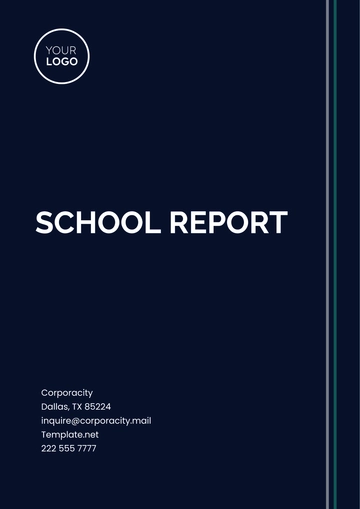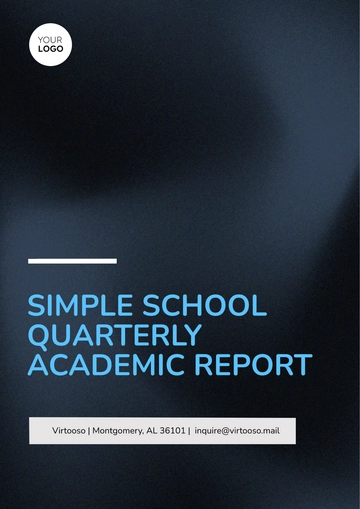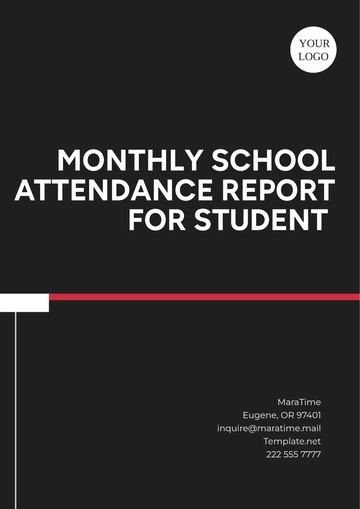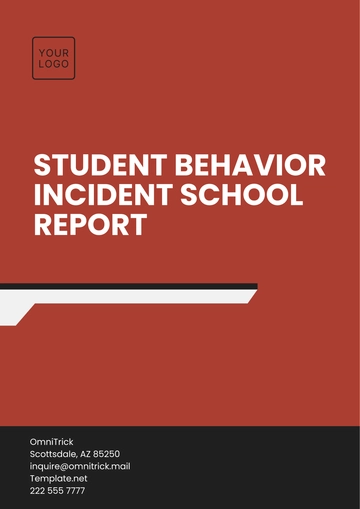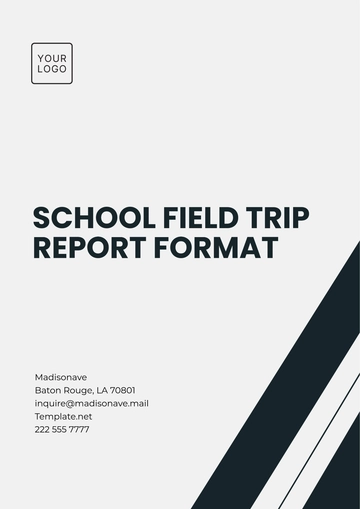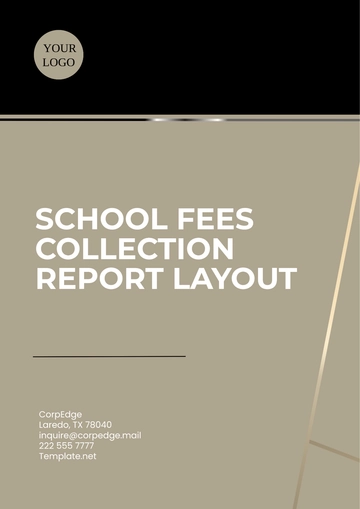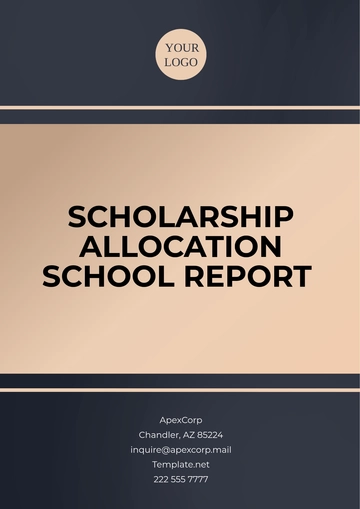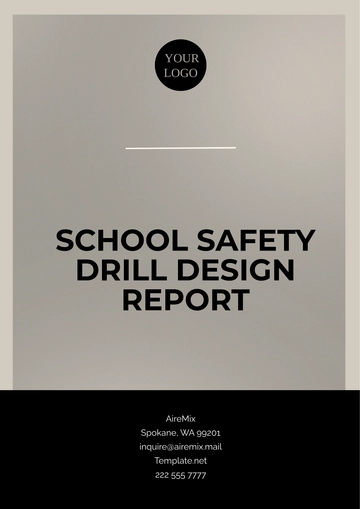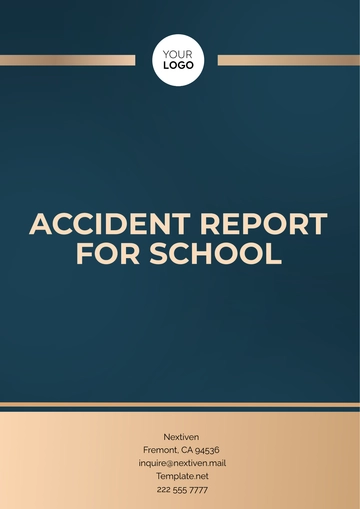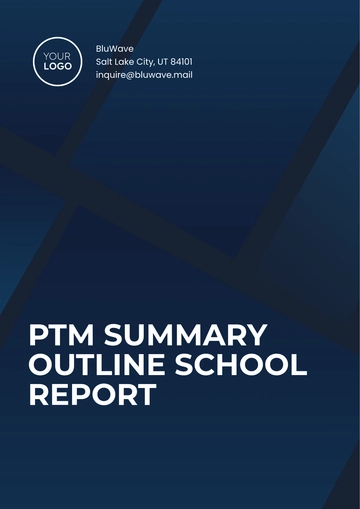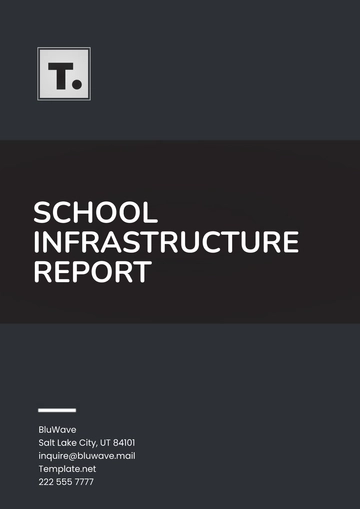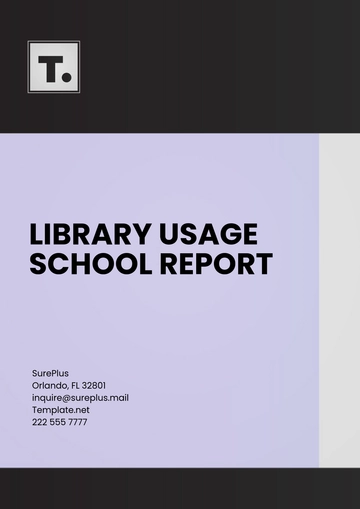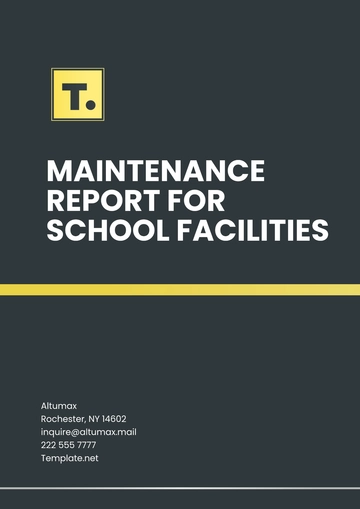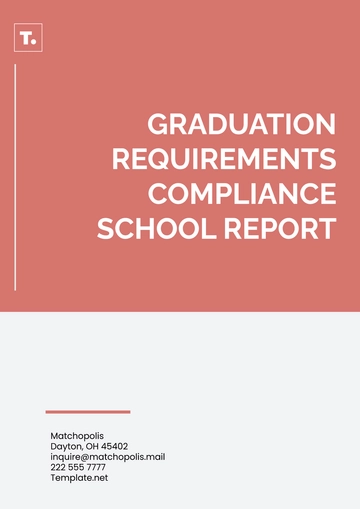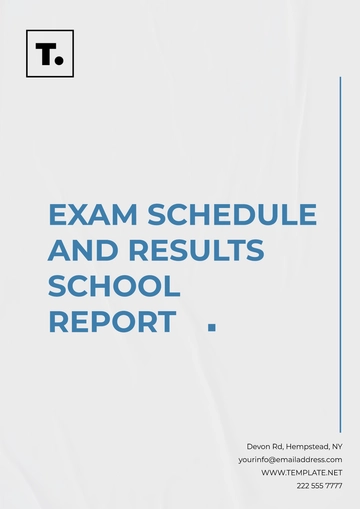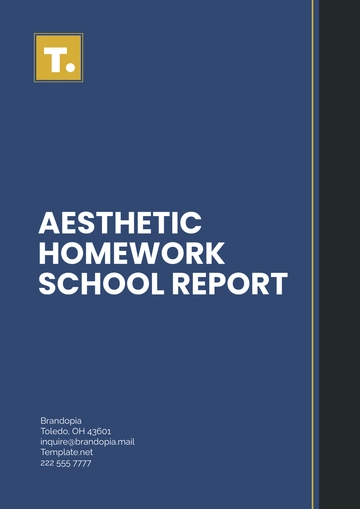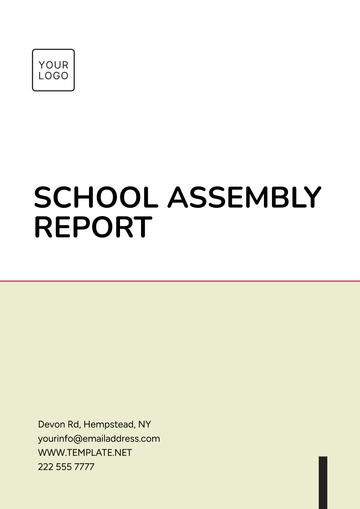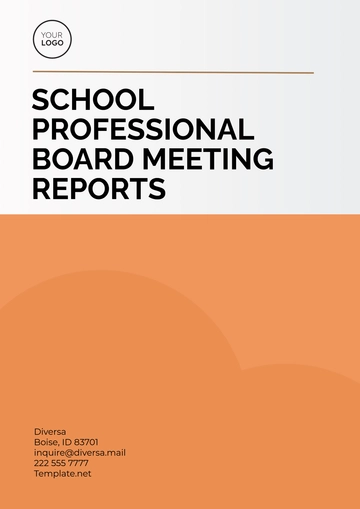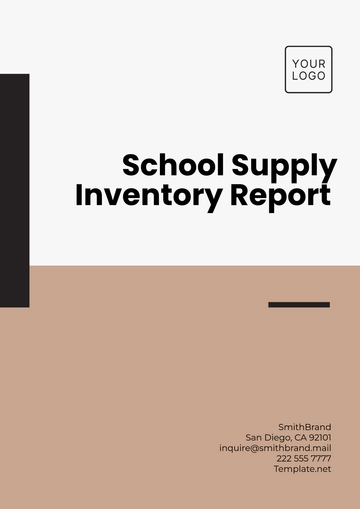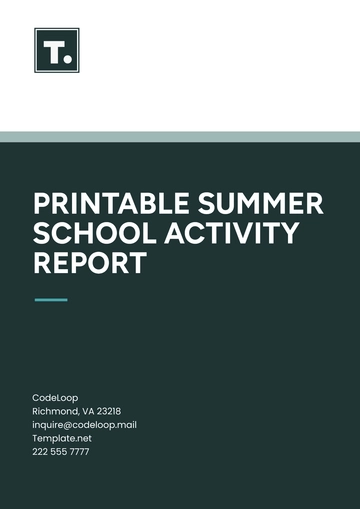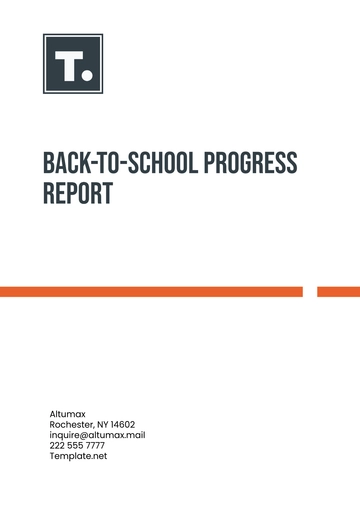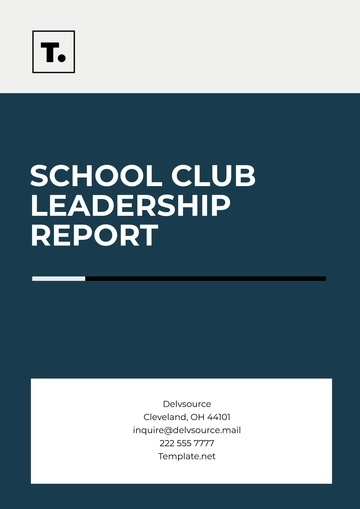Free Elementary School Report
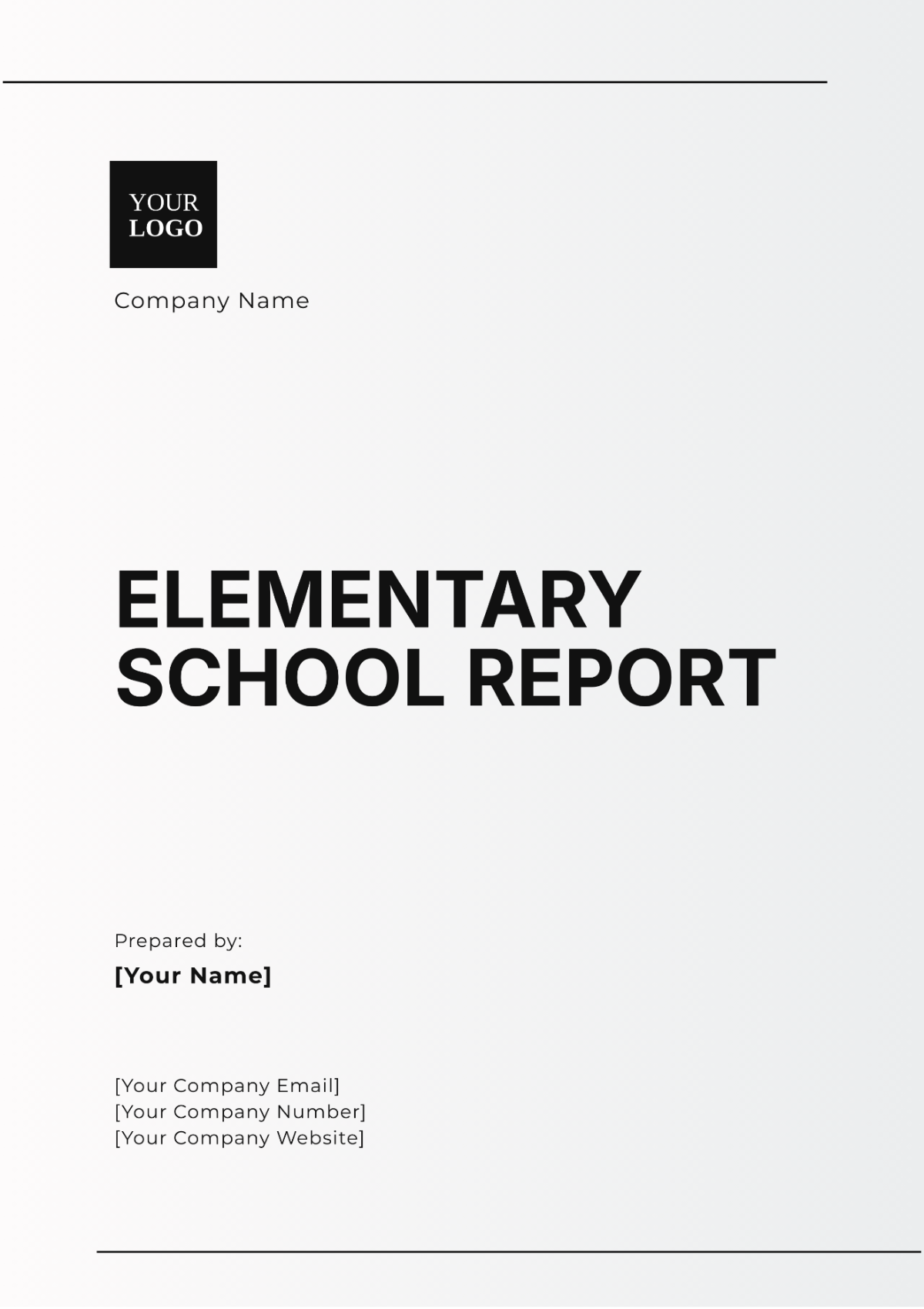
I. Introduction
The academic year [Year] has been a pivotal period for the students of [Your Company Name], marked by significant growth and development. This report serves as a detailed examination of their academic achievements and holistic progress, offering insights into their educational journey. It aims to not only celebrate their successes but also identify areas for improvement and propose actionable recommendations to enrich their educational experience.
Throughout this report, we will delve into various aspects of our students' academic performance and holistic development. By analyzing their achievements, participation in extracurricular activities, attendance records, and behavioral patterns, we aim to paint a comprehensive picture of their educational landscape. This holistic approach allows us to gain a deeper understanding of our students' needs and tailor our efforts to provide them with the support and resources they require to thrive.
II. Academic Performance
This section provides a comprehensive analysis of student performance in key subjects. It includes detailed assessments of Mathematics, Science, English Language Arts, and Social Studies, highlighting average scores, notable achievements, and areas for improvement. By examining these core subjects, we aim to identify trends, strengths, and areas needing enhancement, guiding our efforts to improve academic outcomes for all students.
A. Mathematics
This subsection presents a detailed analysis of student performance in Mathematics, covering average scores, notable achievements, and areas for improvement. It provides a comprehensive view of students' mathematical abilities, highlighting strengths and areas needing development. By examining these metrics, we can identify effective teaching strategies and interventions to enhance students' mathematical proficiency.
Metric | Average Score | Notable Achievements | Areas for Improvement |
|---|---|---|---|
Overall Mathematics | 85% | Several students achieved perfect scores in unit assessments. | Some students struggled with complex problem-solving tasks. |
Arithmetic Operations | 88% | majority of students demonstrated proficiency in basic arithmetic. | Mastery of long division and multiplication techniques required for a few students. |
Algebraic Expressions | 82% | Understanding of basic algebraic concepts such as variables and equations was evident. | Application of algebraic concepts in word problems needs improvement for some students. |
Geometry | 85% | Students showed competence in identifying geometric shapes and properties. | Difficulty in applying geometric formulas to solve problems observed in some students. |
Data Analysis and Probability | 79% | Understanding of data representation and basic probability concepts demonstrated by most students. | Interpretation of complex data sets and probability scenarios requires further development for some students. |
B. Science
This subsection offers a thorough analysis of student performance in Science, including average scores, notable achievements, and areas for improvement. It provides insights into students' understanding of scientific concepts and their ability to apply them. By assessing these aspects, we can tailor our science curriculum to better meet students' needs and foster a deeper appreciation for the sciences.
Metric | Average Score | Notable Achievements | Areas for Improvement |
|---|---|---|---|
Overall Science | 78% | Increased participation in science fairs and competitions. | Understanding of certain scientific concepts, such as the scientific method and basic chemistry principles, needs improvement. |
Biology | 82% | Students demonstrated a good understanding of basic biological concepts, such as cell structure and function. | Understanding of more complex biological processes, such as genetics and evolution, requires further development. |
Chemistry | 76% | Basic understanding of chemical elements and reactions was demonstrated by most students. | Application of chemical principles in solving real-world problems needs improvement. |
Physics | 74% | Understanding of fundamental physics concepts, such as motion and energy, was evident among students. | Mastery of more advanced physics topics, such as electromagnetism and thermodynamics, is required for some students. |
Earth and Environmental Science | 80% | Students showed good comprehension of earth's geological processes and environmental issues. | Application of scientific methods in studying environmental problems needs further development. |
C. English Language Arts
This subsection examines student performance in English Language Arts, focusing on average scores, notable achievements, and areas for improvement. It evaluates students' reading, writing, and communication skills, providing valuable insights into their language proficiency. By analyzing these metrics, we can develop targeted strategies to enhance students' language abilities and literacy skills.
Metric | Average Score | Notable Achievements | Areas for Improvement |
|---|---|---|---|
ELA Overall | 88% | Improved writing skills demonstrated in essays. | Reading comprehension skills need further development. |
Reading Comprehension | 85% | majority of students demonstrated proficiency in understanding and analyzing texts. | Critical analysis and interpretation of complex texts requires improvement for some students. |
Writing Skills | 90% | Students showed significant improvement in structuring essays and using proper grammar and punctuation. | Development of more sophisticated writing styles, including persuasive and narrative writing, is needed for some students. |
Vocabulary | 82% | Understanding and application of a wide range of vocabulary demonstrated by most students. | Expansion of vocabulary and use of context clues for unfamiliar words need improvement for a few students. |
Speaking and Listening Skills | 86% | Effective communication and active listening skills demonstrated in classroom discussions and presentations. | Confidence in public speaking and ability to express ideas clearly and concisely require further development for some students. |
D. Social Studies
This subsection evaluates student performance in Social Studies, including average scores, notable achievements, and areas for improvement. It assesses students' understanding of historical events, geographical concepts, and societal structures. By examining these aspects, we can refine our social studies curriculum to deepen students' knowledge and appreciation of the world around them.
Metric | Average Score | Notable Achievements | Areas for Improvement |
|---|---|---|---|
Overall Social Studies | 82% | Excellent grasp of historical timelines and events. | Deeper understanding of geopolitical issues and their historical context required for some students. |
History | 85% | Understanding of key historical events and figures demonstrated by most students. | Critical analysis of historical events and their impact on society needs improvement for some students. |
Geography | 80% | Proficiency in identifying geographical features and understanding basic map skills shown by students. | Application of geographical knowledge in analyzing global issues, such as climate change and migration, requires further development for some students. |
Civics and Government | 78% | Basic understanding of the principles of democracy and government structures demonstrated by most students. | Understanding of civic responsibilities and participation in government processes needs improvement for some students. |
Economics | 82% | Understanding of basic economic concepts, such as supply and demand, demonstrated by students. | Application of economic principles in analyzing real-world economic issues needs further development for some students. |
III. Holistic Development
This section provides a holistic view of students' development, encompassing their participation in extracurricular activities, attendance records, and behavioral assessments. It offers insights into students' engagement outside the classroom, their attendance patterns, and their behavior and conduct. By examining these aspects, we aim to nurture not just their academic abilities but also their social, emotional, and physical well-being.
A. Extracurricular Activities
This subsection offers an overview of student participation in extracurricular activities, including sports, arts, and clubs. It highlights the variety of activities available to students and their level of involvement. By participating in these activities, students develop teamwork, leadership, and time management skills, enhancing their overall educational experience.
Activity | Number of Students Participating | Level of Involvement | Benefits |
|---|---|---|---|
Sports | 150 | Active participation in various sports | Improved physical fitness, teamwork, leadership, and sportsmanship skills |
Arts | 100 | Regular participation in art classes | Enhanced creativity, self-expression, and appreciation for the arts |
Clubs | 80 | Varied involvement in different clubs | Development of specialized skills, interests, and social connections |
Music | 50 | Participation in music programs | Improved musical abilities, teamwork, and appreciation for different genres |
Drama | 30 | Participation in drama productions | Enhanced acting skills, confidence, and teamwork |
B. Attendance Records
This subsection provides a summary of attendance records, highlighting trends and areas needing attention. It examines factors affecting student attendance and identifies strategies to improve attendance rates. Regular attendance is crucial for academic success, and this analysis helps us ensure that students are fully engaged in their learning.
Metric | Average Attendance Rate (%) | Trends | Areas for Improvement |
|---|---|---|---|
Overall Attendance | 95% | Consistent attendance throughout the year | Addressing tardiness and unexcused absences |
Monthly Trends | Gradual improvement | A steady increase in attendance rates | Implementing rewards for good attendance |
Class-wise Analysis | N/A | Class 5B shows highest attendance rate | Identifying and replicating best practices from Class 5B |
Absenteeism | 5% | Occasional absenteeism in certain classes | Implementing strategies to reduce absenteeism |
Behavioral Assessments
This subsection evaluates student behavior and conduct, including commendations and areas for improvement. It examines discipline issues, classroom behavior, and interactions with peers and teachers. By identifying areas for improvement, we can implement interventions to support students in developing positive behavior patterns and social skills.
Metric | Number of Commendations | Areas for Improvement |
|---|---|---|
Classroom Behavior | 200 | Decrease in disruptive behavior noted |
Peer Interaction | 150 | Encouraging more inclusive behavior among peers |
Teacher Interaction | 180 | Building stronger rapport with teachers |
Discipline Issues | 50 | Addressing instances of misconduct |
Leadership Skills | 100 | Developing leadership qualities among students |
IV. Stakeholder Feedback
This section provides valuable insights from key stakeholders in the educational process: teachers, parents, and students. Their feedback offers a unique perspective on student performance, development, and the overall educational experience. By incorporating their comments and insights, we gain a deeper understanding of the strengths of our educational programs and areas where improvements can be made. This feedback is instrumental in shaping our strategies for continuous enhancement.
A. Teacher Feedback
This subsection presents comments and insights from teachers regarding student performance and development. It offers a valuable perspective on classroom dynamics, teaching methodologies, and student engagement. By analyzing teacher feedback, we can identify effective teaching strategies and areas for improvement in our educational programs.
Teacher ID | Subject Taught | Comments | Areas for Improvement |
|---|---|---|---|
001 | Mathematics | "Students showed significant improvement in problem-solving skills. However, there is a need to provide additional support for students struggling with basic mathematical concepts." | Implementing more interactive and hands-on activities to reinforce mathematical concepts |
002 | Science | "Students demonstrated a strong interest in science experiments and projects. To further enhance their learning experience, more emphasis can be placed on real-world applications of scientific principles." | Incorporating more real-life examples and case studies into science lessons |
003 | English | "There has been notable progress in students' writing skills. To improve further, focus should be given to expanding vocabulary and incorporating more diverse reading materials." | Introducing more challenging reading materials and vocabulary-building activities |
B. Parent Feedback
This subsection provides comments and insights from parents about their children's educational experience and outcomes. It offers valuable information on parental satisfaction, areas of concern, and suggestions for improvement. By incorporating parent feedback, we can strengthen the partnership between home and school, enhancing the overall educational experience for students.
Parent ID | Student Name | Comments | Areas for Improvement |
|---|---|---|---|
101 | [Name] | "We are pleased with the progress [Name] has made this year. However, we feel that more communication about his progress and areas for improvement would be beneficial." | Increasing communication between teachers and parents to provide regular updates on student progress |
102 | [Name] | "[Name] has expressed a strong interest in art and music. We would appreciate it if the school could offer more opportunities for her to explore these interests." | Providing additional extracurricular activities in art and music for students like [Name]. |
C. Student Feedback
This subsection presents comments and insights from students regarding their educational journey and personal growth. It offers a unique perspective on student satisfaction, learning experiences, and areas for improvement. By listening to student feedback, we can create a more student-centered learning environment that meets the diverse needs of our students.
Student ID | Grade Level | Comments | Areas for Improvement |
|---|---|---|---|
201 | 5th Grade | "I enjoy the hands-on science experiments we do in class. It helps me understand the concepts better. I would like more opportunities for group projects." | Incorporating more group projects and collaborative activities into the curriculum |
202 | 6th Grade | "I find the math lessons challenging but engaging. However, I sometimes struggle to keep up with the pace of the lessons." | Offering additional support and resources for students who need extra help in math lessons |
V. Recommendations
Based on the analysis and feedback provided in this report, the following recommendations are made to enhance the educational experience and outcomes at [Your Company Name]:
Recommendation | Description |
|---|---|
Implement targeted interventions in areas requiring academic improvement. | Identify students who are struggling academically and provide them with additional support, such as tutoring or remedial classes. |
Enhance the variety and quality of extracurricular activities offered. | Introduce new extracurricular activities that cater to different interests and talents of students, and ensure that existing activities are engaging and well-organized. |
Strengthen communication channels between teachers, parents, and students. | Implement regular communication methods such as newsletters, parent-teacher meetings, and student-led conferences to keep parents informed about their child's progress. |
Develop programs aimed at improving student attendance and behavior. | Create incentives for good attendance and behavior, and implement strategies to address underlying issues that may be causing absenteeism or disruptive behavior. |
Enhance professional development opportunities for teachers. | Provide teachers with ongoing training and resources to improve their teaching skills and stay updated with the latest educational trends and best practices. |
Implement technology-driven teaching methods. | Incorporate technology into classroom instruction to enhance student engagement and learning outcomes, such as using interactive whiteboards, educational apps, and online resources. |
Establish a student support system for holistic development. | Create a support system that includes counselors, psychologists, and social workers to address the social, emotional, and psychological needs of students, ensuring their overall well-being and development. |
These recommendations are aimed at creating a more enriching and supportive educational environment that fosters academic growth, personal development, and positive student outcomes.
For further information or queries, please contact us at [Your Company Email] or visit our website at [Your Company Website].
- 100% Customizable, free editor
- Access 1 Million+ Templates, photo’s & graphics
- Download or share as a template
- Click and replace photos, graphics, text, backgrounds
- Resize, crop, AI write & more
- Access advanced editor
Discover the Elementary School Report Template on Template.net, designed for seamless efficiency and ease of use. This customizable template is meticulously crafted for educational professionals, ensuring your reports are both comprehensive and visually appealing. Fully editable in our AI Editor Tool, this template saves you time and enhances productivity. Start using this innovative tool to elevate your reporting process today!
You may also like
- Sales Report
- Daily Report
- Project Report
- Business Report
- Weekly Report
- Incident Report
- Annual Report
- Report Layout
- Report Design
- Progress Report
- Marketing Report
- Company Report
- Monthly Report
- Audit Report
- Status Report
- School Report
- Reports Hr
- Management Report
- Project Status Report
- Handover Report
- Health And Safety Report
- Restaurant Report
- Construction Report
- Research Report
- Evaluation Report
- Investigation Report
- Employee Report
- Advertising Report
- Weekly Status Report
- Project Management Report
- Finance Report
- Service Report
- Technical Report
- Meeting Report
- Quarterly Report
- Inspection Report
- Medical Report
- Test Report
- Summary Report
- Inventory Report
- Valuation Report
- Operations Report
- Payroll Report
- Training Report
- Job Report
- Case Report
- Performance Report
- Board Report
- Internal Audit Report
- Student Report
- Monthly Management Report
- Small Business Report
- Accident Report
- Call Center Report
- Activity Report
- IT and Software Report
- Internship Report
- Visit Report
- Product Report
- Book Report
- Property Report
- Recruitment Report
- University Report
- Event Report
- SEO Report
- Conference Report
- Narrative Report
- Nursing Home Report
- Preschool Report
- Call Report
- Customer Report
- Employee Incident Report
- Accomplishment Report
- Social Media Report
- Work From Home Report
- Security Report
- Damage Report
- Quality Report
- Internal Report
- Nurse Report
- Real Estate Report
- Hotel Report
- Equipment Report
- Credit Report
- Field Report
- Non Profit Report
- Maintenance Report
- News Report
- Survey Report
- Executive Report
- Law Firm Report
- Advertising Agency Report
- Interior Design Report
- Travel Agency Report
- Stock Report
- Salon Report
- Bug Report
- Workplace Report
- Action Report
- Investor Report
- Cleaning Services Report
- Consulting Report
- Freelancer Report
- Site Visit Report
- Trip Report
- Classroom Observation Report
- Vehicle Report
- Final Report
- Software Report
